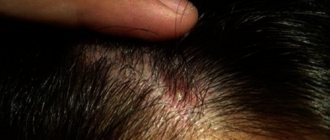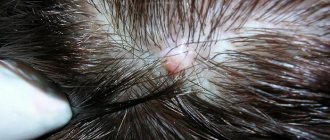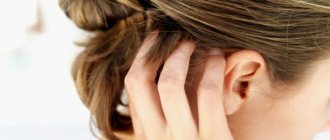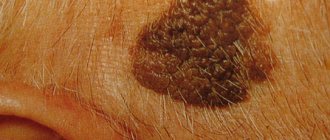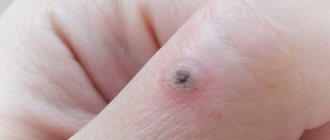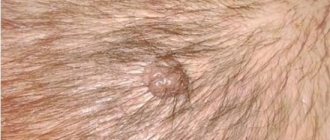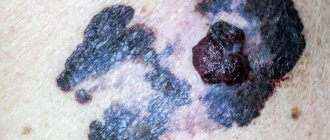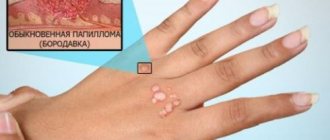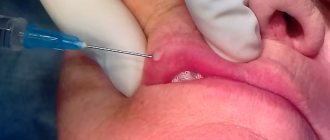What does a wart look like under the hair?
Visually, growths in the scalp area under the hair differ from each other not only depending on the type, but also on how long ago they appeared on the skin:
- At the beginning of their appearance, warts under the hair are beige in color. As they develop, they can change it to brown, red, gray, yellow and others.
- The size is often no more than 1 centimeter, but when multiple growths form on the skin, they grow together and turn into large warts.
- On top, the growths are hard and keratinized. When steaming, the top layer is easily peeled off.
- Keratomas reach large sizes. There are both white and dark brown.
What is a wart?
Our skin has a smooth surface. In some cases, protruding skin growths may appear on it. They are called warts. Usually these are permanent formations that do not change for many years.
The mechanism of wart formation is the growth of the upper layer of skin. The sizes of the formations range from 1 mm to several centimeters. This parameter depends on the type of formation and its location on the skin. Often there is a fusion of several warts. The color of the skin growths is usually flesh-colored, but they can also take on other shades, for example, pink or brown.
Medicine classifies warts as benign neoplasms. They do not grow and do not penetrate surrounding tissues.
In the international classification of diseases, warts are assigned the following codes:
- B07 – viral wart,
- A63.0 – venereal wart,
- L82 – seborrheic keratoma.
Most types of warts are viral, sexually transmitted condylomas are venereal, and senile warts of a non-infectious nature are seborrheic keratomas.
The following skin formations should be distinguished from warts:
- nevi (moles),
- calluses,
- malignant tumors,
- basaliomas,
- condylomas lata, which appear as a result of exposure to syphilis.
Some of these formations can be life-threatening. Therefore, if any suspicious formation appears on the body, you should consult a doctor.
Drug treatment of growths on the scalp
Papilloma on the head, which can be clearly seen in photographs depicting people with HPV, does not arise without reason. Its appearance is provoked by various infections and bacteria. They are the ones who activate the dormant virus by penetrating the skin to the nerve endings.
Papilloma on the scalp can occur for the following reasons:
- Severe stress. Every second person finds himself in stressful situations every day, which have a detrimental effect on his overall health. Due to constant worries and worries, the virus awakens. It begins to move along the nerve canals and finds its way to the skin epithelium. If the virus penetrates cracks in the skin, it immediately appears on the top layer. Pathogenic growths begin to form on it, which indicate activation of HPV;
Severe stress activates HPV
- Infection of damaged skin. Through small cracks, dirt enters the epidermis, which is an ideal environment for pathogenic microbes that activate HPV. This can happen even when simply combing your hair with a comb with too sharp teeth;
- Transmission of the virus from another carrier. People who often use hairdressing services are not immune from this problem. If the master did not properly handle the tools he used while cutting a haircut for a client with HPV, then there is a high probability that the disease will pass from him to a healthy person;
- Hormonal disorders. Skin growths in women often appear during complete hormonal changes. This usually occurs during pregnancy;
- Transmission of severe viral and infectious diseases. They greatly weaken the human immune system, which ceases to control the human immune system. For the same reason, papilloma appears on the head of a child whose immunity has not yet become sufficiently strong;
- Long-term use of potent medications. They are also capable of weakening the body’s defense system;
- Age. Doctors have come to the conclusion that papilloma in the head area is most often diagnosed in older people. It is believed that such growths are not capable of degenerating into cancer, so they are safe for human health.
Usually, the appearance of papillomas on the scalp and body is blamed on a decrease in immunity for one reason or another. Therefore, in order to prevent the development of pathology, you need to be attentive to your own health and regularly strengthen your defense system with beneficial vitamins and microelements.
- exposure to human papillomaviruses (HPV);
- age-related changes.
There are several types of viruses that form papillomas. They are very active, especially those that cause the appearance of simple warts. You can become infected with them through any contact:
- using the personal belongings of a sick person: his dishes, clothes, towels, etc.;
- visiting a bathhouse, sauna;
- in public transport and shops, holding handrails, handles of carts and baskets.
In addition, HPV can be infected from any, even minor, damage to the scalp.
Once in the human body, the virus may not manifest itself for a long time. But as soon as a person’s immunity weakens, the virus begins to act.
- Diseases of the gastrointestinal tract;
- Frequent infectious diseases;
- Certain medications;
- Stress, lack of sleep;
- Bad habits;
- Profuse sweating.
Thus, the appearance of viral warts on the scalp primarily indicates a weakened immune system and a general deterioration in a person’s condition.
First of all, you need to consult a doctor and donate blood for an immunological test. This will help you choose the right medications. Typically, interferon-based products are used to treat growths on the scalp. In addition, they are supplemented with ointments, such as Feresol, creams and ointments based on fluorocyl, salicylic and retinoic acid. You can also analyze the condition of your skin and hair using a trichogram.
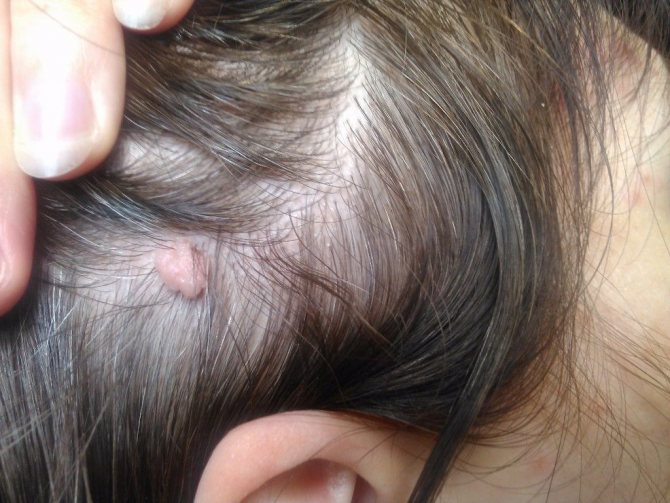
Warts on the head, under the hair, can be of the following types:
- Flat. They are distinguished by a clear contour and do not rise much above the surface of the skin. Their diameter in most cases does not exceed 5 mm. The color may be pink or brown. Papillomas of this type can merge, forming an irregular shape.
- Keratomas. The peculiarity of these warts is that they are observed only in older people. Such warts can appear under the hair, as well as in the temple area. Such growths can itch and cause discomfort.
- Simple. The diameter does not exceed 7 mm. When it appears, it is flesh-colored, but gradually begins to darken. Most often they are formed in large quantities. Such warts must be removed urgently, as there is a possibility of degeneration into a malignant neoplasm.
- Condylomas. They have the shape of a papillary growth, the color is most often pink or red. Such warts can appear at any age, even in children. If the growth is not treated promptly, it will cause pain and discomfort.
The cause of warts is always the human papillomavirus. Infection can occur through personal contact with an infected person, as well as through household items. Symptoms of infection may be absent for several years, so a person does not suspect that he is a carrier of the virus.
The latter is activated, which leads to the appearance of a wart. It can become more active due to weakened immunity, chronic diseases, problems with the gastrointestinal tract, and also due to many other factors.
Symptoms and causes
Warts on the head under the hair are classified into special groups. They can appear either due to infection with the papilloma virus, or under the influence of factors such as age, hormonal changes, or malfunctions of individual body systems.
Symptoms of warts on the head:
- formation that visually resembles cauliflower (the size of the growth may vary);
- round or oval growths on the scalp;
- flat formations of a pink or brownish hue.
A wart on the head in the hair poses a particular danger to humans. Firstly, such growths can go unnoticed for a long time. Secondly, the most common reason for identifying such a formation is its injury.
Causes of warts on the head:
- increased sweating of the head (sweat accelerates the process of virus penetration and its further development);
- abundant accumulations of bacteria (occurs due to poor head hygiene and infrequent hair washing);
- increased secretion of sebaceous glands (may be a feature of the body);
- diseases of the gastrointestinal tract (this group of diseases significantly weakens the body and lowers immunity);
- infectious diseases (can become a complication of this group of diseases);
- constant stressful situations (an unstable emotional state also negatively affects the immunity of the human body);
- abuse of bad habits and lack of a healthy lifestyle (factors lead to a weakening of the body’s protective functions);
- a long course of treatment with potent drugs (a striking example is antibiotics, some of which literally destroy the immune system).
Warts are among the contagious formations. If growths appear on the head, then the risk of spreading them throughout the body increases.
Warts that appear on the head are divided into separate categories. Simple or ordinary types of growths are among the most common types of formations.
- In shape they resemble a large mole or genital papilloma.
- The color is most often gray-yellow or brown.
- Other types of warts on the head include the following:
- Thread-like growths (the name indicates the shape of the growth, and their color is most often pink or flesh-colored).
- Flat types (raise slightly above the skin and have a brownish color).
- Genital condylomas (clearly rise above the surface of the skin; their color can range from flesh-colored to almost black).
- Chicken.
Depending on the type of origin, growths on the head can be keratotic or viral.
The first group is the category of warts, which are most often called seborrheic or age-related. They usually appear in older people. Visually, they resemble moles of different sizes and shapes.
Dermatologists are specialists who specialize in the treatment of warts. Additionally, to identify the causes of growths on the fingers and head, in most cases it is necessary to undergo a full examination, so a visit to a therapist is considered a mandatory step in the diagnosis and treatment of growths.
- Warts may not cause discomfort for many years, but there are cases when it is recommended to consult a specialist as soon as possible.
- Factors for immediately contacting a doctor are:
A wart is never red. If a growth of this color appears on your head, you should consult a doctor as soon as possible. It may not be a wart at all.
Then how to determine whether it is a wart or not? Find out more here. You should also know what else is similar to a wart and how it differs from papilloma.
Treatment options
There is a wide range of methods for removing formations on the head and other parts of the body. When carrying out such procedures, it is important to additionally eliminate the causes of formations.
The main factor contributing to their development is considered to be a reduced level of immunity, so it is recommended to improve your health by taking interferon-based medications.
Methods for treating hanging warts on the head can be divided into three groups - pharmaceutical and folk remedies, clinical methods.
The principle of using pharmaceutical drugs for warts is not complicated.
Wart ointment and cream are applied to the surface of the wart in accordance with the instructions, and the procedures are repeated until the growth completely disappears. Products based on salicylic acid (Salipod patch, creams, ointments) are especially effective.
Additionally, immunostimulating drugs such as Viferon are taken.
Even more pharmaceutical drugs that treat warts can be found here. But remember that they should only be prescribed by a doctor.

In folk medicine there are many recipes against warts.
Acetic acid is considered one of the most effective folk remedies against warts. The substance should be dripped one drop daily onto the growth and within a few days or weeks it should die off.
Other traditional medicine for warts on the head:
- daily lubrication with fresh juice of cabbage leaves;
- rubbing the wart daily with regular chalk;
- Lubricate the growth with castor oil twice a day;
- applications (daily) based on a decoction of wormwood.
They cope well with warts:
- iodine;
- hydrogen peroxide
- garlic;
- celandine;
- fresh potatoes;
- thread.
By the way, based on the latter, there are many pharmaceutical products for removing papillomas; Super Clean is considered one of the cheapest and most effective.
In clinics, warts are removed with special devices that interact with electric current, liquid nitrogen or ultraviolet rays. Surgery is considered an emergency measure to get rid of the growth.
If you want to know which is better: removal with nitrogen or laser, then read the article at the link.
A wart on the head, like other types of growths in this category, should not be treated uncontrolled. There are ways to remove warts at home that are almost identical to clinical procedures.
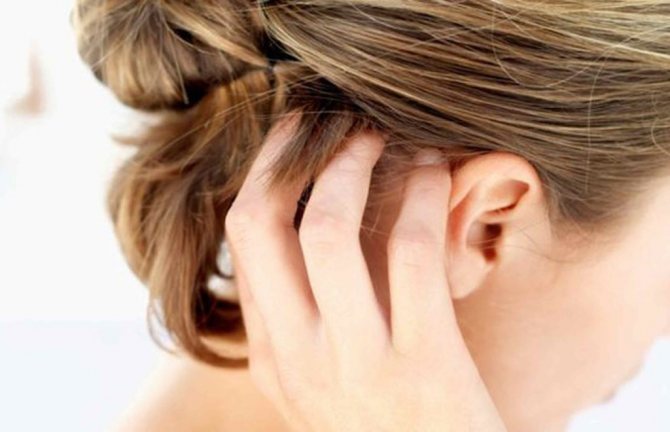
However, before using any product, it is better to consult your doctor in advance. A wart can be not only benign, but also malignant.
A wart on the head in the hair has the following features:
- Formation similar to the head of a pin.
- Easily injured. Doctors recommend removing such growths using various methods in order to avoid the development of complications.
- If warts form on the head, then over time they can spread to the face, affecting the nose, cheeks, ears, and sometimes the tongue.
Warts on the head under the hair grow due to hyperhidrosis, hypersecretion of the sebaceous glands, infection, nervous strain, the use of certain medications, and problems with the gastrointestinal tract.
A neoplasm on the head is formed due to the following factors:
- Excessive sweating of the head. The formation of sweat promotes the rapid penetration of the human papillomavirus and accelerates its subsequent development.
- Presence of bacteria. It occurs when a person does not maintain hygiene and rarely washes his hair.
- Increased secretion of sebaceous glands.
- Gastrointestinal diseases. Such pathologies affect the overall functioning of the body and contribute to the deterioration of immunity.
- Infectious diseases.
- Frequent nervous tension. The psycho-emotional state is directly related to other systems of the body, in particular the immune system.
- Having bad habits and an unhealthy lifestyle.
- Use of potent drugs. For example, certain types of antibiotics have a detrimental effect on the immune system.
How to remove HPV on the head at home
Removing a wart on the head without leaving home can be done using medications or traditional medicine. The essence of therapy is to destroy the pathological process and neutralize the virus. Without resorting to the help of a specialist, tumors can be removed in different ways.
Methods for removing condylomas:
- Using ointments. On the pharmaceutical market you can purchase antiviral ointments that have a negative effect on HPV (Oxolinic ointment, Viferon, Acyclovir, Panavir). To remove papillomas, preparations based on acids and trace elements (Salicylic and Zinc ointments) are also used. Recently, a new Chinese drug, SanFenZhong, has appeared on pharmacy shelves, which has a burning effect on warts.
- Removal using Cryopharma, an analogue of cryodestruction. This drug works on the principle of nitrogen cauterization, but at home. One bottle of Cryopharma is enough for 12 procedures.
- Cauterization with alkaline solutions. The most popular product from this series is Super Celandine. To remove small skin growths, one procedure is enough, and you can forget about the wart forever. Larger growths require re-cauterization after a week.
Before using any method of removing warts on the head at home, you need to consult a specialist. Using diagnostics, he will determine the type of HPV and select the most optimal course of therapy.
Removal
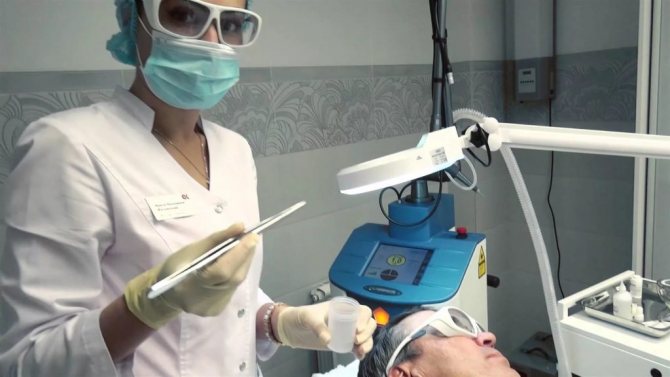
Many people are interested in how to remove a wart on the head. Currently, there are many methods that involve the most gentle procedure possible. Modern techniques have virtually no contraindications, and undesirable consequences occur extremely rarely. The following methods are used:
- Laser wart removal. It is the most popular and effective way. The laser beam instantly excises the growth, cauterizes all capillaries and vessels at the site of its impact. One procedure is enough to completely get rid of the wart. For such manipulations, local anesthesia is used. During the procedure, the patient does not feel pain or discomfort. After this, no scar remains.
- Cryodestruction. Liquid nitrogen is used for this manipulation. The action is based on complete freezing of the growth, which completely kills its cells. After some time, the wart disappears on its own. The disadvantage of this technique is that in most cases one procedure is not enough; a whole course is required. There is also a possibility of injury to surrounding tissues.
- Electrocoagulation. The technique is based on the effect of electric current on the wart. After cauterization, a small stain remains, which subsequently disappears completely. The procedure is completely painless as local anesthesia is used. This technique, when performed correctly, significantly reduces the likelihood of wart re-formation.
- Removal using a scalpel. It is an outdated method and is used extremely rarely. It is only advisable if the growths are localized over a large area. Excision occurs with a small area of healthy skin. The rehabilitation period after such manipulation takes a long period and requires the patient to follow special wound care rules.
It is necessary to choose a method for removing warts from the scalp only after consultation with a specialist. The right method will help you get rid of warts and also avoid possible complications. All manipulations should be carried out only after diagnostic measures and a thorough personal examination.
- Laser. A modern effective method for removing skin tumors, performed under local anesthesia. Read more about the method here
- Cryodestruction. This is the removal of growths using liquid nitrogen. The skin around them is not damaged and no scars remain.
- Electrocoagulation. The growth is burned out by high-frequency current, which causes the death of viruses. This is a bloodless method of removing tumors.
- Extensive, fused growths on the scalp are removed surgically.
Vulgar warts
This type of wart occurs in 70% of cases. It is caused by the papilloma virus. Externally, vulgar (ordinary) papillomas look like small semicircular formations on the surface of the skin. They are usually completely painless. The sizes of the formations range from several mm to 1 cm. Their surface is usually uneven, lumpy, and can often resemble the surface of cauliflower. Color – flesh-colored, grayish, yellowish-brown. Frequent localizations are hands, face, fingers, lips, knees, elbows. Mucous membranes are rarely affected.
Often, ordinary papillomas can go away on their own. The peculiarity of papillomas of this type is that they often grow not individually, but in groups. You can often find a large papilloma with small ones growing around it. If you remove the largest (maternal) papilloma, then the smaller ones usually disappear.
Ordinary papillomas can occur at any age. They often occur in school-age children.
Photo: Wart vulgaris/shutterstock.com
Symptoms and signs
Warts on the scalp appear in the form of single rashes, which are often reinforced over time by the appearance of daughter growths. The surface of such formations is rough and keratinized, and the color may vary. They appear in the head due to infection with the human papillomavirus. At first, a person may not notice the wart and pay attention to it only after it is damaged by a comb or scissors during a haircut.
The main threat of warts on the head under the hair is the likelihood of developing skin cancer.
Treatment options
Treatment of warts in children and adolescents.
The appearance of warts on the scalp during adolescence is often caused by hormonal changes occurring in the body and goes away over time. Therefore, there is no need to rush to remove them.
The same applies to growths that appear in young children. The reason for their appearance is weakening of the immune system. The formation of papillomas is caused by dirt getting into scratches, cuts and irritated skin.
Baby warts have the shape of nodules that resemble seaweed. In addition to the head, they appear on the face and hands. Heavy sweating also provokes the appearance of growths on the scalp in children.
However, children's warts should not be removed either, since they disappear without a trace with age. Strengthening the child’s immunity with the help of immunomodulators and vitamin-mineral complexes will help get rid of them. According to the doctor's recommendations, medicinal ointments can be used.
Is there any danger?
The appearance of a wart on the head in most cases has a positive prognosis. In exceptional situations, growths cause a precancerous condition. But, despite this, doctors agree that it is important to get rid of warts that affect the skin of the head, regardless of their type. To begin with, they resort to treatment with medications, and then they get rid of the growth using the method chosen by the attending doctor.
As long as the skin growth on the scalp is small, it does not cause any particular problems. A person may not even notice its presence or simply not attach any importance to papilloma. But this is a wrong action. Papillomas on the head in the hair must be removed in the initial stages of development. Thanks to this, it will be possible to avoid the possible degeneration of the growth into an oncological tumor. In addition, the papilloma will gradually grow and cause inconvenience.
A large growth will certainly be touched during the process of combing the hair, coloring it and shaping it into a hairstyle. An injured scalp papilloma will begin to become inflamed and painful. All this will lead to an even greater increase in size. In addition, overgrown warts are much more difficult to remove.
Folk remedies for the treatment of warts
- Lubricate the growth two to three times a day with iodine until it falls off
- Drizzle lemon juice on it. The wart will be destroyed by fruit acids
- Apply celandine juice to the growth 3 times a day
- Every day, drip acetic acid on it.
- Apply tincture of wormwood.
But we warn you once again that self-medication of a wart, especially a large one, threatens its injury and degeneration. So before using folk remedies, consult your doctor. Remember that your health is in your hands.

The appearance of skin tumors that resemble nodules and tubercles in appearance is caused by various reasons.
Typically, a wart on the head in the hair is a benign neoplasm that is not inflammatory in nature.
The growth has sharply defined contours and occurs against the background of infection with the papilloma virus. Melanomas, unlike warts, are malignant tumors of non-infectious origin.
Hard or soft tubercles, elongated papillae on the skin cause a lot of trouble. Most people call any growths on the body “warts,” but skin tumors have different origins and require adequate treatment. There are warts of viral origin and non-infectious etiology.
The most common skin growths are usually benign or precancerous.
The appearance of the growth depends on the cause of the change and the properties of the skin of a particular person, the location and duration of the appearance of the tumor. Almost all types of warts initially look like flesh-colored or brown pimples. Large growths on the head under the hair and on the face can be flat and lumpy, relatively smooth and rough.
Lumps under the hair on the head cause discomfort, although they are less noticeable than on the face and hands. However, the risk of damage is higher due to combing, cutting, and styling the hair. Getting rid of a wart on the head is especially difficult if the tumor becomes inflamed and increases in size. The reasons for unfavorable changes can be different, both internal and external.
Growths of different origins differ in appearance and tendency to malignancy (malignancy).
- unsuccessful attempts to self-treat skin tumors;
- diseases of internal organs, endocrine system;
- increased HPV activity with weakened immunity;
- injuries and any other damage to the skin;
- increased secretion of sebum by the sebaceous glands;
- profuse sweating, increased skin moisture;
- foci of infection in the body;
- dermatological diseases;
- taking certain medications;
- chronic stress.
A large number of people are susceptible to viral warts. Papillomavirus is present in the skin of 70–80% of the population, although it does not appear in every HPV carrier. Some skin growths go away on their own (without treatment). Most often, the number and size of warts increase with age, making it extremely difficult to get rid of them.
One or more benign lesions appear after infection with the human papillomavirus (HPV). In the initial stages, the growths are flesh-colored or pinkish-pearl in color. They change with age and acquire a grayish-yellow or brown color. The diameter is up to 10 mm, and larger tumors are formed by the fusion of several growths.
The shape and size of warts of infectious origin depend on the type of virus (more than 100 different HPVs are known).
Human papillomavirus types 1, 2, 4 and 7 cause warts vulgaris. They have the form of hard growths with a rough horny surface and are localized on the head, face, arms and legs.
Condylomas are soft growths in the shape of a cockscomb, a mushroom on a knife, or cauliflower.
- spread from the site of initial growth to other areas of the head, face, neck and upper body;
- gradual increase in size, tendency to merge;
- absence of hairs growing from the nodule;
- there is no skin pattern on the surface.
HPV infection occurs through domestic and sexual contact, and the virus is also transmitted to the child from the mother during childbirth. The virus infects the layer of skin at the border of the epidermis and dermis, where increased proliferation and keratinization of cells begins.
From the moment of infection to the formation of a growth, it takes from several weeks to 10–15 years.
The effectiveness of treatment methods for such formations on the skin of various origins is much higher when the causes of their appearance are taken into account. To determine the type of skin tumor, the doctor conducts a dermoscopic examination - the growth is examined under magnification. If necessary, the dermatologist prescribes a blood test and laboratory tests of tumor tissue.
Surgical excision, laser therapy, radioknife, electrocoagulation are radical methods of getting rid of warts.
In the dermato-cosmetology office, the patient may be offered cryodestruction, that is, freezing growths on the skin using low-temperature liquid nitrogen.
Pathological tissues are destroyed, the tumor dies with the formation of a crust on the skin. Various methods of destruction of growths can achieve a cosmetic effect and reduce the activity of HPV.
Methods for removing warts are not without drawbacks, which include the risk of tumors appearing in the same place or other areas of the skin. Surgical removal of large growths may leave noticeable scars. Hardware techniques, in particular laser therapy, are highly effective, but will require significant financial expenses (if there are a large number of warts).
How can you remove a wart on your own or with a doctor?
Medicines for getting rid of viral papillomas belong to the group of antitumor drugs, immunomodulators, antioxidants and adaptogens. The patient may be prescribed injection solutions, capsules for oral administration, rectal suppositories containing active substances with antiviral effects (Cycloferon, Viferon, Interferon).
Warts are treated externally, affecting the pathological tissues of the neoplasm with various aggressive substances.
Potent components - trichloroacetic, salicylic, lactic acid, alkalis and phenols - are present in many drugs. These are Salicylic ointment, Collomak, Super Celandine, Dermavit, Antipapillom, Ferezol, Verrukacid. Freezing with subsequent death of warts ensures external use of aerosols with dimethyl ether - Cryopharma, Wartner Cryo.
You can remove warts on the head under the hair with iodine tincture, salicylic acid solution, povidone-iodine, castor oil. The growths should be treated several times a day. Natural and synthetic antiviral components are contained in preparations based on medicinal plants - ointments, creams and lotions Celandine, balms Mountain Celandine, Papilek.
Different peoples have recipes for getting rid of warts using natural remedies. The milky juice of celandine is used everywhere. The orange liquid is squeezed out from all parts of the herb and applied strictly to the wart itself.
Celandine juice turns warts and papillomas brown. When liquid gets on healthy skin, a burning and itching sensation is sometimes felt. The wart dies off after a few days or weeks. Lemon juice, apple cider vinegar, tincture and celandine oil are used in the same way.
Getting rid of existing warts on the head and preventing new ones is carried out using a paste of apple cider vinegar and sea salt (4:1). Or soak the peel of a banana, orange or onion, as in the photo. Then it is applied to the growth (secured with a bandage). It begins to die off within a few days of starting treatment.
Most folk remedies are harmless, and vinegar, castor oil, and essential oils are even beneficial for scalp hair. However, home treatment should not be treated as a completely safe procedure.
The aggressive substances in vinegar and plants may not kill, but only activate the papilloma virus, as a result the size of the wart on the body will increase, or growths will begin to appear on other areas of the skin.
This material is posted for educational and informational purposes, does not constitute professional medical advice or scientific material and cannot serve as a substitute for medical advice.
How to distinguish viral warts?
One or more benign lesions appear after infection with the human papillomavirus (HPV). In the initial stages, the growths are flesh-colored or pinkish-pearl in color. They change with age and acquire a grayish-yellow or brown color. The diameter is up to 10 mm, and larger tumors are formed by the fusion of several growths.
The shape and size of warts of infectious origin depend on the type of virus (more than 100 different HPVs are known).
